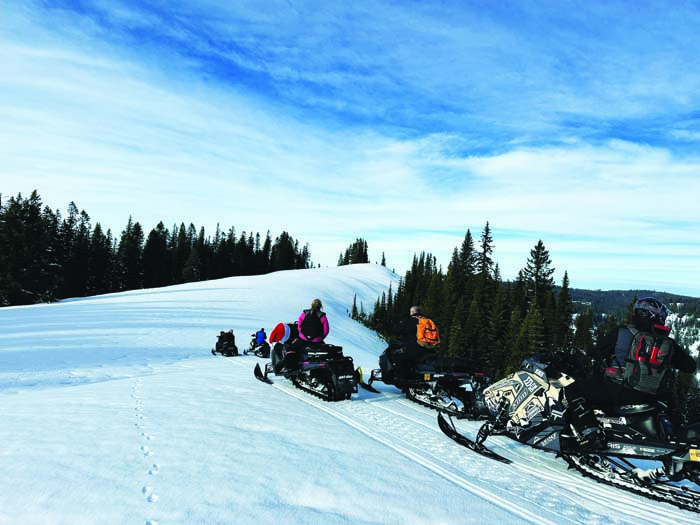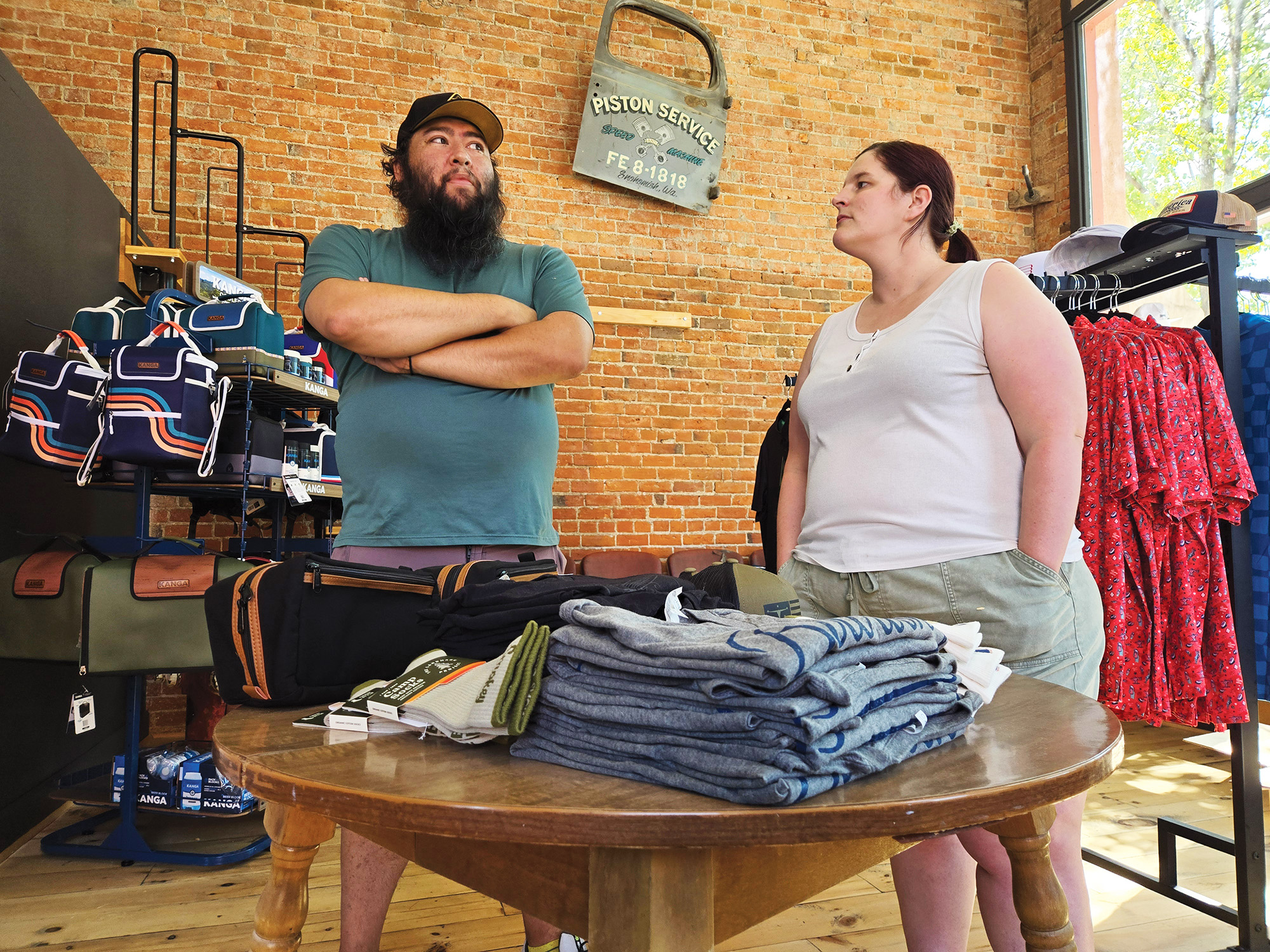Lack of storms stymies snowmobilers in Northeast Oregon
Published 3:00 pm Thursday, January 4, 2024

- Snowmobilers in the northern Blue Mountains in December 2023.
BAKER CITY — Snowmobile trail groomers are about as useful this winter as a speedboat in a desert.
Trending
So far, anyway.
There are quite a few of these tracked machines around Northeast Oregon, fueled and ready to aim their blades down a trail to create a smooth surface for snowmobile riders.
But El Nino has relegated the groomers to their sheds and garages.
Trending
The weather pattern spawned by warm water in the Pacific Ocean has shunted storms away from Oregon, and indeed much of the West, for the past several weeks.
Although there’s sufficient snow in some areas for snowmobiling, the depths are too modest to require — or even to allow — grooming.
If the snow depth is skimpy, groomers could end up unearthing rocks or leaving areas bare — precisely what riders don’t want.
“It has been predominantly nonexistent,” is Dustin James’ assessment of the snowmobile grooming season.
James is with the Wallowa County Gamblers, one of several snowmobile clubs in the region whose volunteer members groom more than 1,500 miles of trails across the Blue Mountains.
Aside from one major storm after Thanksgiving, the skies have been exceedingly stingy, James said.
“It’s been one of the top two slowest starts I’ve seen in my recollection,” he said on Tuesday, Jan. 2. “Very skinny.”
Brandon Christensen corroborates James’ dismal description.
“It’s the slowest start we’ve had in over 20 years,” said Christensen, a past president of the Tollgate Trail Finders Snowmobile Club, which grooms hundreds of miles of trails in the northern Blues on both sides of Highway 204 between Elgin and Weston.
“Definitely not an average winter.”
Mike Bogart, president of the Sumpter Valley Snowmobilers, called the situation “really disturbing.”
Sumpter, the historic gold mining town about 28 miles west of Baker City, is one of the snowmobiling hubs in Northeast Oregon, the center of a network of about 350 miles of trails.
During most winters, snowmobilers can start their rides right from town — no need to haul their sleds on a trailer to a mountain trailhead.
The same is true for the Sumpter Valley Snowmobilers club’s groomer.
Bogart said the club doesn’t have a trailer for its groomer — it’s unnecessary.
Unfortunately, the groomer hasn’t been necessary either.
“We’re just not getting any precipitation,” Bogart said.
Another haven for snowmobilers in Baker County is Halfway, in the Pine Valley just south of the Wallowa Mountains about 53 miles east of Baker City.
Although Halfway’s elevation is just 2,600 feet, its location near the Wallowas puts it in a microclimate where heavy snow is common in winter. The Pine Valley frequently has two or more feet of snow even while higher valleys, such as Baker, which is in the rain shadow cast by the Elkhorns, has much less.
The Panhandle Snowmobile Club, based in Halfway, grooms hundreds of miles of trails and maintains the Clear Creek Sno-Park on the road to Fish Lake.
Duane Miles of the Panhandle club said its groomer, like those elsewhere in the region, has remained parked.
“We’re definitely off to a slow start,” he said on Wednesday, Jan. 3. “We’re praying for snow.”
Miles said that although there’s enough snow for riding in the Fish Lake area, with a couple feet of snow, that’s well below average for the area, elevation about 6,700 feet.
Last year at this time, he said, the club’s snow-measuring pole near Fish Lake was covered up to about the seven-foot mark.
Riding ungroomed trails
Christensen said the Tollgate club, which has two groomers, typically needs 18 to 24 inches of snow to start grooming.
There was about three feet of snow in the Tollgate area after an early December storm, but Christensen said the snow settled so quickly that there wasn’t time to start grooming. Since then, very little snow has fallen.
Snowmobilers are still getting out on the ungroomed trails, Christensen said, although the numbers during the holidays were below average.
He said he went riding on Dec. 29 on “vintage iron” — a 1995 Yamaha sled — and “we had an absolute ball out there.”
“I was surprised by how good the trails were,” he said.
Bogart, from the Sumpter club, said he’s talked with snowmobilers who rode in the area around Christmas, but they reported that conditions were poor.
“It’s not good riding, that’s for sure,” Bogart said.
James, from the Wallowa County Gamblers, said the club typically doesn’t start grooming until the snow is at least 18 inches deep.
He said he’s ridden a couple of times in Wallowa County, but the shortage of snow at lower elevations makes it hard for riders to access the deeper snow higher in the mountains.
Kevin Cassidy, who lives in Baker Valley and is a longtime snowmobiler, said he’s ridden twice in the Anthony Lakes area and once around Tollgate, where he rode to Bone Springs north of Tollgate.
But Cassidy said he’s just “waiting it out” — hoping for the new year to bring storms more typical of winter.
Cassidy said he remembers other years when snow was scanty in December, but the weather pattern changed in January, February and March and delivered the prime snowmobiling conditions that riders covet.
“There’s lots of winter left,” he said.
Forecast looks more promising
Club officials all said they’re optimistic that the return to wintry weather earlier this week will continue.
The National Weather Service is predicting more than a foot of snow for the northern Blue Mountains during this weekend, with a series of additional storms possible next week.
The agency is also predicting the El Nino pattern to weaken as winter progresses, which could mean the latter part of winter is much snowier.
If that proves true, Christensen expects to see more typical weekend scenes, with trucks and snowmobile trailers lined up in parking areas.
“People are anxious to get out,” Christensen said.
Snowmobilers are accustomed to being able to start riding around Thanksgiving in the Tollgate area, he said.
Although the northern Blues are modest in elevation, with most areas under 6,000 feet, the region is in the path of winter storms that frequently track east along the Columbia River. The Blues are the first major mountain range these storms encounter, and as the air rises and cools, prodigious amounts of snow fall. The snow depth at the summit along Highway 204 near Tollgate, 5,158 feet, often has deeper snow than at elevations of 7,000 feet or higher in the Elkhorns or Wallowas.
Christensen said the Tollgate trails are also popular because they’re relatively close to population centers including Pendleton, Hermiston, Walla Walla, Milton-Freewater and the Tri-Cities.
Miles said the Panhandle club should be able to start limiting grooming, including the popular trail to the Fish Lake area, after a foot of snow has fallen.
Safety precautions
In addition to carrying food, water and other supplies in case of a mechanical problem, snowmobilers should keep track of avalanche danger, Cassidy said.
The Wallowa Avalanche Center — https://wallowaavalanchecenter.org/ — issues avalanche and weather forecasts and warnings for the Wallowas, Elkhorns and northern Blues.
Victor McNeil, the center’s executive director, posted a report on the website from a trip he made Dec. 29 to the Catherine Creek area in the western Wallowas. At an elevation of 7,300 feet, McNeil dug a snow pit to examine the layers within the snow, which was three feet deep.
McNeil wrote in his report that the bottom eight inches of the snow, from a storm in late October, was weak.
“Due to the nature of the events that played out this fall, we have a persistent slab problem in our snowpack,” McNeil wrote. “The bottom of the snowpack has weak snow. Only time will tell how the weak snow at the bottom of the snowpack will react when we see more of a load.”
McNeil said in an interview on Thursday, Jan. 4 that that lowest layer consists of “sugary” snow that is unstable. That layer is widespread throughout the region, he said, since the late October storm dropped snow on all the local mountain ranges.
“The analogy is building a house with a poor foundation,” McNeil said. “That’s the layer we’re most concerned about.”
As new snow accumulates, the additional weight will increase the chances that the sugary snow will slide, he said.
Eventually, the overlying layers of snow will compress the snow beneath and ideally change the shape of the snow crystals, somewhat reducing the avalanche risk, McNeil said.
Although snow can slide spontaneously, some avalanches are triggered by a person, either a skier, snowboarder or snowshoer, or a snowmobile or other vehicle, he said.
The depth of snow above a weak layer has a direct effect on the danger of human-caused slides.
McNeil said a skier, boarder or snowshoer typically exerts enough force to potentially affect snow layers about three feet below the surface.
A snowmobile, being much heavier, can spawn a slide that starts as much as eight feet below the snow surface, he said.
Economic effects
Snowmobiling isn’t just a recreational activity in Northeast Oregon.
It’s also an economic driver.
Miles, with the Panhandle Snowmobile Club in Halfway, population 350, said he usually sees eight to 10 snowmobile trailers in town during the week between Christmas and New Year’s.
This year he saw only a couple.
Miles said many visitors, some of whom travel from Idaho or other states, often stay in local motels and patronize restaurants and other businesses.
Although the number of visitors typically peaks after the holidays, Miles said the scarcity of snow early in the winter will have an effect.
“That’s already money lost to these businesses,” he said.
Dianna Welch, manager at the Halfway Motel & RV Park, said business “has been really slow” so far this winter.
A group of snowmobilers who had made reservations for the first week of 2024 called to cancel due to the lack of any recent storms, Welch said.
And she had no snowmobilers as guests during the week between Christmas and New Year’s Day, a period when large groups of riders often are in town.
Snowmobilers are also a significant source of business in Sumpter, population about 210.
But so far this winter there haven’t been many riders around, said Jeremiah Collins, a cashier at the Sumpter Nugget cafe.
State association
Northeast Oregon snowmobile clubs are among the 25 members of the Oregon State Snowmobile Association (OSSA), based in Bend.
The association’s website — oregonsnow.org — has a variety of information about clubs and events, as well as tips for buying snowmobiles.
There are multiple types of sleds, including models powered by 2- and 4-stroke engines, as well as a range of track length that help determine whether a machine is better suited for deep powder in off trail situations or for gliding along groomed trails on more moderate terrain.
Riders who have a valid driver’s license can operate a snowmobile. But if you don’t have a license — children too young to drive a car, for instance — you’ll need a snowmobile operators permit, which requires taking a class sponsored by a local club or the OSSA.
“It’s the slowest start we’ve had in over 20 years.”
— Brandon Christensen, Tollgate Trail Finders Snowmobile Club









